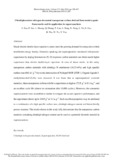JavaScript is disabled for your browser. Some features of this site may not work without it.
| dc.contributor.author | Zou, Jizhao | |
| dc.contributor.author | Liu, Peng | |
| dc.contributor.author | Huang, Lin | |
| dc.contributor.author | Zhang, Qi | |
| dc.contributor.author | Lan, Tongbin | |
| dc.contributor.author | Zeng, Shao-Zhong | |
| dc.contributor.author | Zeng, Xierong | |
| dc.contributor.author | Yu, Liang | |
| dc.contributor.author | Liu, Shiyu | |
| dc.contributor.author | Wu, Hongliang | |
| dc.contributor.author | Tu, Wenxuan | |
| dc.contributor.author | Yao, Yuechao | |
| dc.date.accessioned | 2020-01-22T14:39:15Z | |
| dc.date.available | 2020-01-22T14:39:15Z | |
| dc.date.issued | 2018-04-03 | |
| dc.identifier.citation | Yao Y, Tu W, Zou J, et al., (2018) Ultrahigh-content nitrogen-decorated nanoporous carbon derived from metal organic frameworks and its application in supercapacitors. Electrochimica Acta, Volume 271, May 2018, pp. 599-607 | en_UK |
| dc.identifier.issn | 0013-4686 | |
| dc.identifier.uri | https://doi.org/10.1016/j.electacta.2018.03.200 | |
| dc.identifier.uri | https://dspace.lib.cranfield.ac.uk/handle/1826/14993 | |
| dc.description.abstract | Single electric double-layer capacitors cannot meet the growing demand for energy due to their insufficient energy density. Generally speaking, the supercapacitors introduced with pseudo-capacitance by doping heteroatoms (N, O) in porous carbon materials can obtain much higher capacitance than electric double-layer capacitors. In view of above merits, in this study, nanoporous carbon materials with ultrahigh N enrichment (14.23 wt%) and high specific surface area (942 m2 g−1) by in situ introduction of N-doped MOF (ZTIF-1, Organic ligands 5-methyltetrazole/C2H4N4) were produced. It was found that as supercapacitors' electrode materials, these nanoporous carbons exhibit a capacitance as high as 272 F g-1 at 0.1 A g−1, and an excellent cycle life (almost no attenuation after 10,000 cycles.). Moreover, the symmetric supercapacitors were assembled to further investigate the actual capacitive performance, and the capacitance shows up to 154 F g-1 at 0.1 A g−1. Such excellent properties may be attributed to a combination of a high specific surface area, ultrahigh nitrogen content and hierarchically porous structure. The results shown in this study fully demonstrate that the nanoporous carbon materials containing ultrahigh nitrogen content can be used as a potential electrode material in supercapacitors. | en_UK |
| dc.language.iso | en | en_UK |
| dc.publisher | Elsevier | en_UK |
| dc.rights | Attribution-NonCommercial-NoDerivatives 4.0 International | * |
| dc.rights.uri | http://creativecommons.org/licenses/by-nc-nd/4.0/ | * |
| dc.subject | Ultrahigh nitrogen-decorated | en_UK |
| dc.subject | Supercapacitor | en_UK |
| dc.subject | MOF-Derived | en_UK |
| dc.title | Ultrahigh-content nitrogen-decorated nanoporous carbon derived from metal organic frameworks and its application in supercapacitors | en_UK |
| dc.type | Article | en_UK |
Files in this item
The following license files are associated with this item:
This item appears in the following Collection(s)
-
Staff publications (SATM) [4365]

